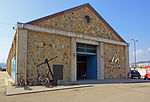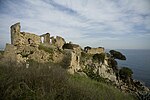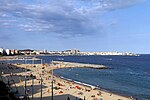Palamós

Palamós (Catalan pronunciation: [pələˈmos]) is a town and municipality in the Mediterranean Costa Brava, located in the comarca of Baix Empordà, in the province of Girona, Catalonia, Spain. Palamós is located at the northern end of a large bay. The town is by-passed by the C31 which connects the coastal towns of the central Costa Brava with Girona. Palafrugell lies 8.5 kilometres (5.3 mi) to the north and Castell-Platja d'Aro 7 kilometres (4.3 mi) to the south.Palamós is a staging point on the GR 92 long distance footpath, which runs the length of the Mediterranean coast of Spain. Stage 8, to the north, follows the cliffs to the beach at La Fosca before taking an inland route to Calella de Palafrugell and then following the coast again through Llafranc, Tamariu and Fornells de Mar to the next staging point at Begur, a distance of 23.0 kilometres (14.3 mi). Stage 9, to the south, follows the beachfront promenade to Sant Antoni de Calonge and then the coast through Platja d'Aro and S'Agaró to the next staging point at Sant Feliu de Guíxols, a distance of 16.8 kilometres (10.4 mi).
Excerpt from the Wikipedia article Palamós (License: CC BY-SA 3.0, Authors, Images).Palamós
Carrer de Joan Maragall,
Geographical coordinates (GPS) Address Nearby Places Show on map
Geographical coordinates (GPS)
| Latitude | Longitude |
|---|---|
| N 41.85 ° | E 3.1291666666667 ° |
Address
Carrer de Joan Maragall
Carrer de Joan Maragall
17230
Catalonia, Spain
Open on Google Maps










